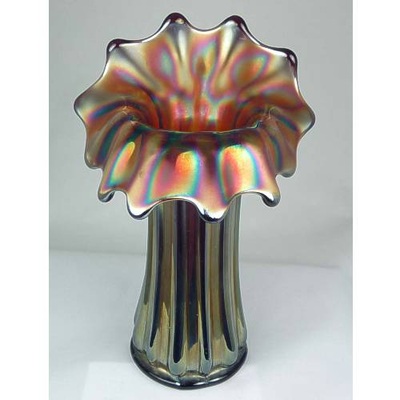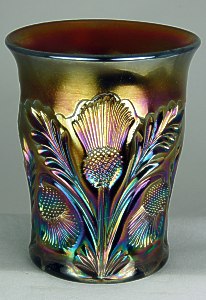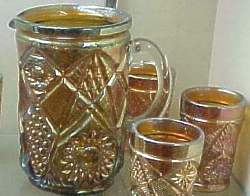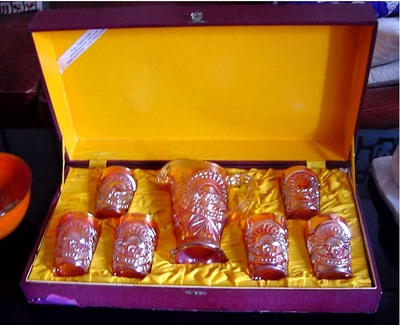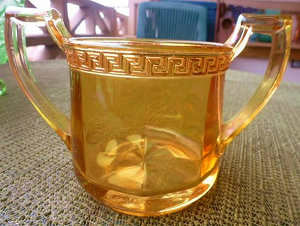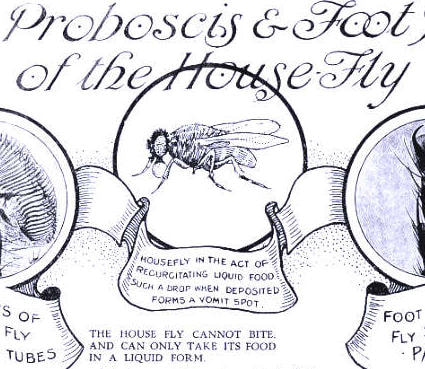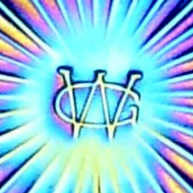Other USA Makers
Westmoreland, the United States Glass combine and Cambridge were significant glassmaking operations, but the amount of Classic Carnival that they produced was much less than that from the “Big Five” (Dugan-Diamond, Fenton, Imperial, Millersburg and Northwood). Nevertheless, it was significant.
Other makers, such as Fostoria, also contributed small amounts of Classic Carnival.
Other makers, such as Fostoria, also contributed small amounts of Classic Carnival.
Cambridge (Ohio)
|
Cambridge opened in 1902, leasing its factory from the National Glass Company, with moulds acquired from other glassmakers. In 1910 it became independent of National, operating its own coal mines and natural gas wells. After several owners, the plant closed in 1958. Imperial acquired the moulds, making limited use of them in the 196Os. Imperial closed in 1984 and some of the moulds went to other glassmakers such as Fenton and Summit Art Glass. Fenton altered the moulds before use, but Summit did not. The remaining moulds are now owned by National Cambridge Collectors, Inc (NCCI). Source & image courtesy of NCCI. Cambridge produced some beautiful Carnival using intaglio designs that were often marked NEARCUT. Their Inverted Strawberry and Inverted Thistle patterns are very sought after. |
Lancaster Glass Company (Ohio)
|
The Lancaster Glass Company may not be a familiar name to Carnival Glass collectors, as they made only a relatively limited range of Carnival Glass - pressed, iridised glass with a moulded pattern - dating probably from around 1910-15. However, their later iridescent Stretch Glass lines dating from the 1920s, are known to many in shapes such as comports, candies and bonbons. It is evident that iridescent glass – Carnival – was in the line at Lancaster in 1909, as the January 9th 1909 edition of “China, Glass and Lamps” featured a line of vases by Lancaster in “Crystal, Iridescent, Lustre and Ruby”*. However, so far very little of it is documented or recognised. We feature several Lancaster patterns, many of them being confirmed attributions to this maker using catalogue evidence of their manufacturer. |
Westmoreland (Pennsylvania)
|
Westmoreland was founded in 1889 at Grapeville PA, where there was abundant natural gas, and the Pennsylvania railroad for shipping in raw materials and moving out the finished products. They produced all types of glassware, with a particular reputation as a maker of novelty goods and glass containers. They also made interesting (and often unique) pieces of Carnival, such as the Orphan Annie sugar and creamer set shown here in a 1908 Butler Brothers catalogue. It described the iridescence as "Egyptian Iridescent" with “a beautiful, iridescent luster surface and gold lining”. This was undoubtedly Carnival Glass, and its “gold lining” was the gold effect of the iridescence inside the items. They entered the Revival Carnival Glass market in 1974, making a wide range of colours, shapes and patterns, until they closed in May 1984. |
U.S. Glass (from Pennsylvania to Indiana)
|
Founded in 1891, the United States Glass Co was, from the start, a combination of many glass companies operating across four states. It made a small range of Carnival, with some distinctive colours such as honey amber used for many Palm Beach items, as shown in the above Butler Brothers ad from 1912. It appears some of their moulds were sold to and/or copied in South America. The Rising Sun and Omnibus patterns were first made by US Glass and are known in slightly altered versions found mainly in Argentina. US Glass certainly exported to various countries, but other factors suggest that there was production in South America. |
Read and see more about these makers - click on any image.




